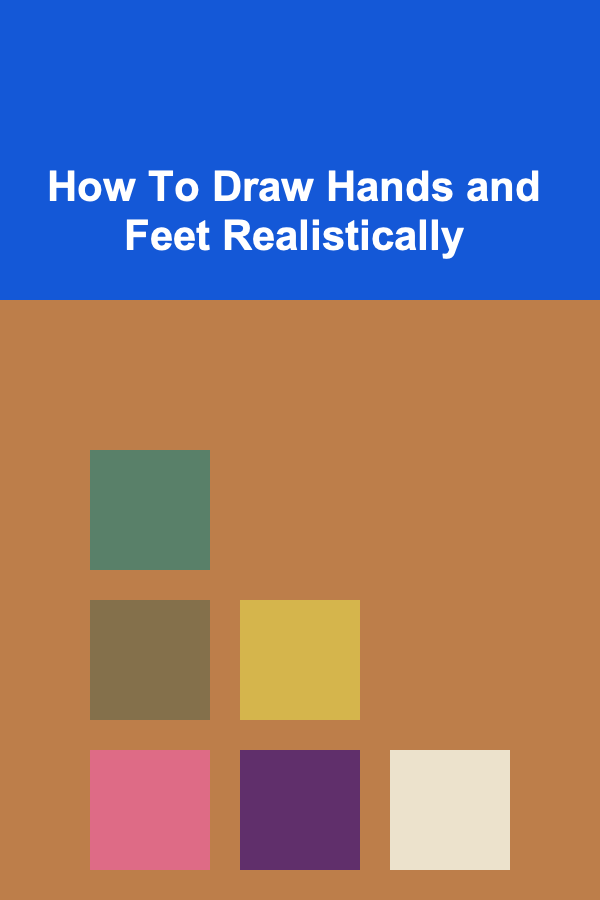
How To Draw Hands and Feet Realistically
ebook include PDF & Audio bundle (Micro Guide)
$12.99$10.99
Limited Time Offer! Order within the next:

Drawing hands and feet with realism is a challenge even for seasoned artists. These complex, expressive body parts have intricate structures and are often a difficult task for beginners or even intermediate artists to capture accurately. Yet, hands and feet are integral to conveying emotion and action in art, so learning how to depict them realistically is a rewarding skill that elevates your work.
In this guide, we will explore the fundamental techniques and approaches to drawing hands and feet in a realistic way. By understanding the underlying anatomy, proportions, and key tips, you can create more believable and expressive artwork.
Understanding the Anatomy of Hands and Feet
To draw hands and feet realistically, the first step is to understand their anatomy. Both parts are composed of bones, muscles, tendons, and skin, all working together to allow for movement and flexibility. A realistic depiction of hands and feet requires an understanding of these structures and how they move.
Hand Anatomy
A human hand consists of 27 bones, divided into three categories:
- Phalanges (fingers): Each finger has three phalanges (except the thumb, which has two). The fingers are crucial for detailed movement and expression, and each joint allows for different types of bending and flexibility.
- Metacarpals (palm): The five metacarpal bones make up the palm. They are connected to the fingers through the knuckles, which are often the most prominent features when drawing the hand.
- Carpals (wrist): The eight small carpal bones make up the wrist, and these are key in determining the angle and movement of the hand.
When drawing hands, you must take into account the complex interactions between these bones and muscles. The hand's versatility comes from the way these structures allow for different positions, gestures, and movements.
Foot Anatomy
The human foot consists of 26 bones and serves as the foundation of the body, supporting weight and providing balance. The major components of the foot include:
- Phalanges (toes): Like the fingers, the toes are made up of phalanges. The big toe has two phalanges, while the other toes have three each.
- Metatarsals: The five metatarsal bones form the middle part of the foot and support the arch. These bones give the foot its strength.
- Tarsals (ankle): The seven tarsal bones make up the back portion of the foot and help with mobility, balance, and support.
The foot's arch is essential for weight distribution, and understanding its curves and alignment can help you accurately represent the foot's structure in your drawings.
Techniques for Drawing Hands Realistically
Now that we have a basic understanding of the anatomy of hands and feet, let's focus on the techniques for drawing hands realistically. Here are some fundamental steps to follow.
1. Break the Hand into Basic Shapes
To simplify the process, start by breaking the hand into basic geometric shapes. This will help you focus on proportions and structure before adding intricate details.
- Palm: Begin by drawing a rectangular shape for the palm. You can make it wider at the top and narrower at the bottom, reflecting the natural contours of the palm.
- Fingers: Draw the fingers using simple cylinders or elongated rectangles. Focus on the basic shapes and positioning of the fingers, ensuring that they follow the natural curve of the hand.
- Thumb: The thumb has its own unique positioning and flexibility. Begin by sketching it separately and angle it toward the base of the palm.
- Knuckles: The knuckles should be represented as circles or small ovals on the surface of the hand. They give the hand its three-dimensional form.
2. Study the Proportions of the Hand
Hands have specific proportions that are important for achieving realism. For example:
- The length of the fingers should be roughly equal to the length of the palm.
- The middle finger is typically the longest, and the index finger is slightly shorter than it.
- The thumb is placed lower and extends from the base of the palm at an angle.
By following these proportions, you'll ensure that your hand looks balanced and anatomically accurate.
3. Add Detail to the Fingers and Palm
Once the basic shapes are in place, refine the fingers, adding more detail to the knuckles, nails, and skin folds. The fingers should not be perfectly straight; they have natural curves that should be reflected in your drawing.
Focus on the subtle details that make hands look realistic:
- Knuckles: These are important for adding depth to your drawing. They should be slightly raised and have subtle shadows around them to reflect the bending of the joints.
- Fingernails: The fingernail shapes should follow the natural curves of the finger. Add highlights to give them a reflective, shiny quality.
- Skin folds: Hands have various skin folds, especially at the joints. Pay close attention to these details, as they can make the hand look more lifelike.
4. Add Shadows and Depth
Shading is critical to making your hand appear three-dimensional. Start by identifying the light source in your scene, and use shadows to create depth and dimension. Pay particular attention to the shadows cast by the fingers, knuckles, and wrist, as these areas will help define the form of the hand.
5. Practice Gesture and Movement
Hands are incredibly expressive, so practicing dynamic gestures can improve the realism of your drawings. Gesture drawing allows you to capture the natural movement and positioning of the hand, rather than focusing on a static pose.
Use quick sketches to capture a range of hand gestures. Don't worry about perfection; the goal is to focus on the movement and energy of the hand, which will make it feel more alive.
Techniques for Drawing Feet Realistically
Drawing feet involves similar principles to drawing hands, but there are unique challenges because of the foot's structure and its function as a weight-bearing part of the body. Let's go through the steps for drawing feet.
1. Break the Foot into Basic Shapes
Start by simplifying the foot into basic shapes, much like you did with the hand. This will help you get the proportions and structure right.
- Heel: Begin by sketching the heel as a triangular or wedge-shaped form.
- Arch: The arch of the foot is critical for a realistic depiction. Draw a curved line for the arch that connects the heel to the toes.
- Toes: Sketch the toes as simple oval shapes, starting with the big toe at the front and following the natural curve of the toes.
2. Study Foot Proportions
Feet have specific proportions to keep in mind:
- The length of the foot is generally about the same as the length of the forearm.
- The width of the foot should be slightly wider at the toes and narrower at the heel.
- The toes gradually decrease in length, with the big toe being the longest.
Correct proportions are vital for making the foot look realistic, so pay attention to these measurements as you sketch.
3. Add Detail to the Toes and Arch
Once you've outlined the basic shape, refine the details of the toes and arch:
- Toes: Draw the individual toes with their distinct shapes. The big toe is typically more square, while the other toes are more tapered.
- Arch: The arch should curve smoothly, and the position of the foot will affect how pronounced the arch appears. Keep in mind that the arch varies from person to person.
4. Add Shadows and Depth
As with hands, shading is key to adding realism to the foot. Identify where the light is coming from and add shadows accordingly. The arch and toes should cast shadows, and the heel will typically be darker than the toes. Use softer shading for the skin on the top of the foot and more intense shadows in the creases and under the arch.
5. Pay Attention to Details and Skin Folds
Feet have many small details that contribute to their realism:
- Toe Nails: Similar to fingernails, toe nails should have slight highlights to show the reflective nature of the nail.
- Skin Folds: The skin on the top of the foot and around the ankle has natural folds. These should be emphasized to give the foot a more realistic look.
6. Practice Foot Positions
To draw feet effectively, you need to practice different positions and angles. Start by drawing the foot in its basic form, then experiment with different stances and angles, such as standing, walking, or pointing the toes.
The most common issue when drawing feet is getting the positioning and perspective right. Use references or photographs to study how the foot moves in space, and apply that knowledge to your drawings.
Combining Hands and Feet in One Drawing
Once you're comfortable with drawing hands and feet individually, you can start incorporating them into more dynamic compositions. Combining hands and feet in a single piece requires attention to perspective, gesture, and anatomy to ensure both parts work harmoniously together.
1. Use Gesture Drawing
Gesture drawing is essential when you're combining hands and feet in one composition. This approach helps you capture the movement of both the hands and feet in a natural, fluid way. Focus on how the hand and foot work together, whether in action or in repose.
2. Maintain Proper Proportions and Angles
Pay careful attention to the proportions and angles of both hands and feet. They should be in proportion to the rest of the body, and the perspective should be consistent. This is especially important when drawing hands and feet in foreshortened perspectives or in more dynamic, three-dimensional poses.
Conclusion
Drawing hands and feet realistically is a skill that requires patience and practice. By understanding the anatomy of these complex body parts, simplifying their structures into basic shapes, and focusing on key techniques like shading and proportions, you can achieve lifelike and expressive depictions. Remember, drawing is a continuous learning process, so don't get discouraged if your first attempts aren't perfect. With time, you'll be able to confidently depict hands and feet in any situation, bringing your art to life.
Reading More From Our Other Websites
- [Beachcombing Tip 101] Hidden Gems of the Deep: Uncovering Nature's Oceanic Treasures
- [Biking 101] Cycling Tips to Improve Your Speed and Endurance
- [Organization Tip 101] How to Create a Checklist for Back-to-School Shopping
- [Biking 101] Why Fat Bikes Are Perfect for Winter Riding and Off-Road Adventures
- [Home Holiday Decoration 101] How to Set the Mood with Holiday Lighting in Every Room
- [Personal Care Tips 101] How to Apply Nail Polish on Short Nails
- [Home Cleaning 101] How to Clean Your Home on a Budget
- [Home Cleaning 101] How to Clean a Washing Machine: Tips for a Spotless Appliance
- [Home Budget Decorating 101] How to Create a Statement Wall Without Spending Too Much
- [Home Soundproofing 101] How to Soundproof a Home Near Train Tracks or Airports?

How to Build a Checklist for Setting a Meeting Agenda
Read More
How to Use Home Organizing Skills to Make Money
Read More
The Ultimate Guide to Brand Strategy: A Brand Manager's Handbook
Read More
How To Deal with Bullying: For Parents and Kids
Read More
How to Create a Reptile Feeding Checklist Based on Species
Read More
10 Tips for Conducting Ethical Sociological Research
Read MoreOther Products

How to Build a Checklist for Setting a Meeting Agenda
Read More
How to Use Home Organizing Skills to Make Money
Read More
The Ultimate Guide to Brand Strategy: A Brand Manager's Handbook
Read More
How To Deal with Bullying: For Parents and Kids
Read More
How to Create a Reptile Feeding Checklist Based on Species
Read More